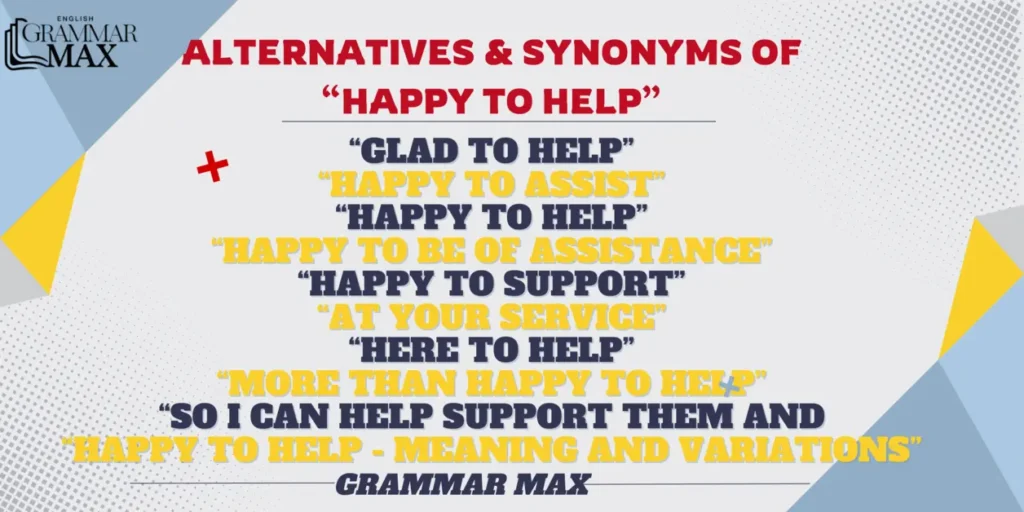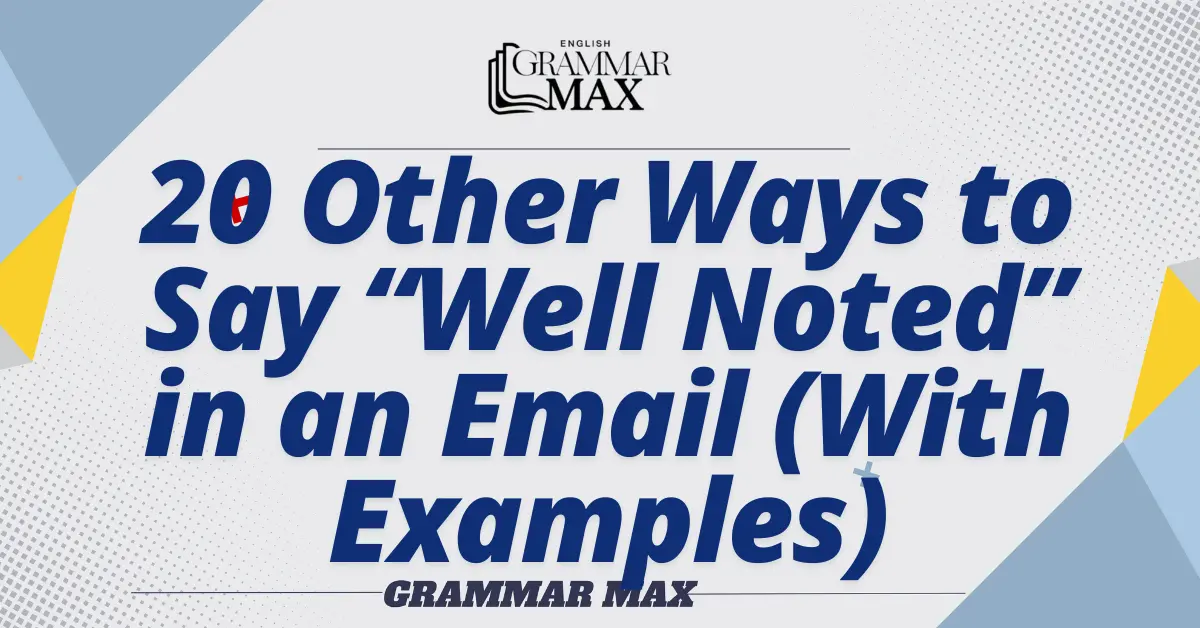Happy to help is a phrase we often use in professional and casual settings, expressing our willingness and readiness to assist others. But as versatile as it is, there are times when you may want to use other expressions to convey the same sentiment.
Whether you’re responding to a colleague’s gratitude, assisting a client, or closing a conversation, finding alternative ways to say “happy to help” can add variety to your language and elevate your professionalism. Here, we’ll explore 10 effective alternatives, each with explanations and examples to help you integrate these phrases naturally into your daily communication.
“Happy to help” synonyms and alternatives to avoid saying it

You can use these alternatives and synonyms instead to say “Happy to Help”:
- Glad to Help
- Happy to Assist
- Always Happy to Help
- Happy to Be of Assistance
- Happy to Support
- At Your Service
- Here to Help
- More Than Happy to Help
- So I Can Help Support Them And
- Happy to Help – Meaning and Variations
Glad to Help
Using “Glad to help” conveys a warm tone and shows genuine enthusiasm for assisting. It’s a friendly alternative, suitable for informal and professional interactions alike. By saying “glad,” you add a personal touch, which can make your response feel a bit more heartfelt.
Glad to help also maintains a balance between warmth and professionalism, making it an excellent choice for team communication or client interactions. It shows that you’re pleased to assist without sounding overly formal.
Example:
Email response:
“Hi Sarah,
I’m glad to help with the details you needed! If there’s anything more you’d like to discuss, feel free to reach out.
Best,
John”
Happy to Assist
Happy to assist works perfectly in formal settings. This phrase provides a subtle yet effective way to express that you’re readily available to offer support. It’s often used in customer service or professional emails to convey a polite readiness to help.
This phrase also implies a level of professionalism that “happy to help” might lack in more formal settings. Happy to assist can work particularly well in industries where maintaining a courteous tone is key.
Example:
Customer support email:
“Dear Ms. Rogers,
Thank you for reaching out! I’m happy to assist with any further questions you may have about our services.
Warm regards,
Customer Support Team”
Always Happy to Help
When you use “Always happy to help,” you indicate that your support is consistent and dependable. This phrase is ideal for team settings where reliability and commitment are valued, as it conveys ongoing readiness to be of assistance.
By adding “always,” you highlight that your support is more than just a one-time offer, enhancing the sense of trust and collaboration among colleagues.
Example:
Team communication:
“Hey team,
Just a quick note to say I’m always happy to help with any extra tasks during this busy season. Don’t hesitate to reach out!
Best,
Michael”
Happy to Be of Assistance
Happy to be of assistance is a refined, polite way to express willingness to help. It’s a bit more formal than “happy to help,” making it ideal for professional emails, particularly with clients or senior colleagues.
This phrase also subtly reinforces that you’re providing help within your professional capacity. Happy to be of assistance is suitable for maintaining a respectful tone in your interactions.
Example:
Professional email:
“Dear Mr. Jameson,
I’m happy to be of assistance as you work through the project details. Please let me know if you need further guidance.
Warm regards,
Lisa”
Happy to Support
Happy to support is an excellent choice when you want to show encouragement and involvement. This phrase is particularly useful when collaborating with team members or working on a project where your support may extend over time.
Using happy to support also implies that you’re there for ongoing assistance, not just for a one-time interaction. It works well in collaborative environments, showing that your help is active and continuous.
Example:
Project communication:
“Hi everyone,
I’m happy to support this initiative and contribute wherever possible. Let me know where I can step in.
Cheers,
Emma”
At Your Service
At your service is a classic, polite way to express that you’re available to help. This phrase is perfect for adding a touch of formality, often found in customer service settings or formal interactions with clients.
Using at your service can give your response a refined, courteous tone, conveying that you’re dedicated to fulfilling the recipient’s needs.
Example:
Client interaction email:
“Dear Ms. Collins,
I’m at your service for any further questions you may have about our product. Looking forward to assisting you further.
Sincerely,
Alex”
Here to Help
Here to help is a straightforward way to offer assistance without overcommitting. It’s an ideal choice in quick, informal messages, especially when responding to someone needing guidance or support.
By saying here to help, you imply availability without sounding overly formal or committed. It’s a versatile phrase that fits a wide range of professional and informal scenarios.
Example:
Quick message:
“Hi Max,
If you need anything else regarding the project, I’m here to help. Just send me a message.
Thanks,
Jen”
More Than Happy to Help
More than happy to help conveys a high level of enthusiasm, showing that you’re delighted to offer assistance. This phrase is effective for strengthening relationships with clients or teammates, adding a touch of warmth.
This phrase shows that you’re not just willing, but enthusiastic, about providing assistance, which can enhance rapport and create a positive impression.
Example:
Friendly client email:
“Hi Anna,
I’m more than happy to help with the setup. Please feel free to reach out if you need additional support!
Best,
Mark”
So I Can Help Support Them And
In situations where you’re indirectly offering help, “so I can help support them and” is effective for showing support on behalf of others. It’s ideal when explaining your role in team or collaborative projects.
This phrase is slightly different from direct assistance, as it implies helping in a broader capacity. So I can help support them and by explaining why you’re involved in a project or collaboration.
Example:
Team project email:
“Hi team,
I’ve joined the project to help support them in streamlining the process. Please keep me updated on any tasks I can handle.
Thanks,
Peter”
Happy to Help – Meaning and Variations
Understanding happy to help meaning and its variations can enhance your professional communication. This phrase, often used in customer service and corporate settings, conveys genuine eagerness to assist without excessive formality.
When you understand happy to help meaning, you can apply this phrase in a way that fits various professional scenarios, providing a consistent and approachable tone.
Example:
Customer support follow-up:
“Dear Mr. Thomas,
Just wanted to check if everything is going well with your recent purchase. As always, I’m happy to help if you have more questions.
Kind regards,
Customer Service Team”
What is the Happy to Help meaning in professional communication?
The Happy to Help meaning in professional communication conveys a willingness and enthusiasm to assist others, whether colleagues, clients, or customers. It implies that the person offering help is approachable and ready to support without hesitation. This phrase is often used to build positive rapport and demonstrate commitment to meeting others’ needs.
Frequently Asked Questions
Is it correct to say “happy to help”?
Yes, saying “happy to help” is perfectly correct and widely accepted in both professional and casual settings to convey a willingness to assist.
What is another word for “happy to help”?
Alternatives include “glad to help,” “happy to assist,” and “at your service,” all expressing a readiness to offer support.
How do you say I am happy to help you?
You can say “I’m glad to help” or “I’m here to assist you” to convey the same supportive tone.
How do you formally say “happy to help”?
Formally, you might use “happy to be of assistance” or “happy to support” to maintain a courteous, professional tone.
Conclusion
In today’s world of fast-paced communication, having alternatives to happy to help can elevate your interactions, showing that you’re both thoughtful and adaptable. These expressions give you the flexibility to adapt your tone based on the context, whether it’s a formal email, a friendly check-in, or a collaborative project update.
Each phrase here adds a unique nuance, allowing you to convey enthusiasm and willingness without repetitive language. From always happy to help to happy to assist, these phrases enable you to offer support in ways that feel fresh and genuine, enhancing your professionalism and rapport with colleagues and clients alike.

William Henry is a writer for Grammar Max, a blog that focuses on synonyms and phrases. He loves exploring the quirks of the English language and enjoys helping readers improve their vocabulary. William’s articles are easy to read, fun, and full of useful tips for anyone looking to better understand and use English. Whether you’re a student, a professional, or just someone interested in language, William’s writing on Grammar Max makes learning about words and their meanings simple and enjoyable.





